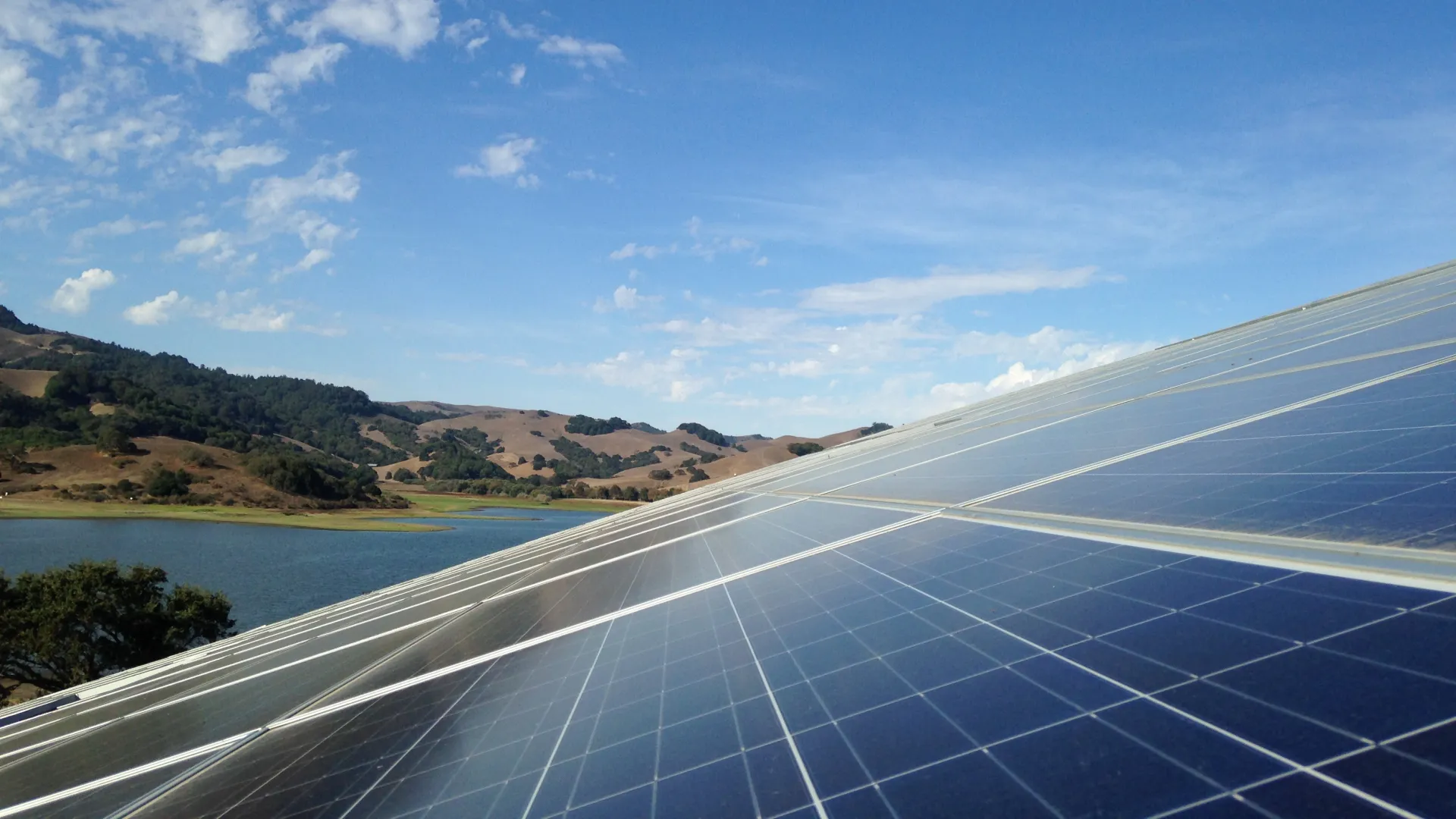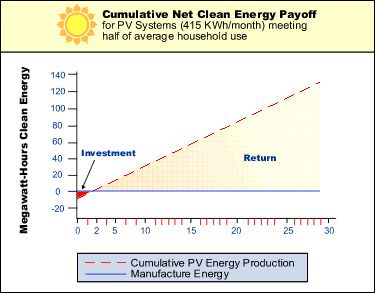
Solar Energy Myths & Facts
Solar energy is a rapidly growing field and there are a lot of myths regarding solar power. Many of the arguments against solar are based on outdated or incorrect information. We are setting the record straight on some of the most common solar energy myths:
MYTH #1: Solar panels require more energy to manufacture than they produce in their lifetime.
FACT: A study by the National Renewable Energy Laboratory conclusively demonstrates that the manufacturing energy cost versus the energy production payback for solar modules is generally less than 4 years.

"Reaping the environmental benefits of solar energy requires spending energy to make the PV system. But as this graphic shows, the investment is small. Assuming 30-year system life, PV-systems will provide a net gain of 26 to 29 years of pollution-free and greenhouse-gas-free electrical generation … So, for an investment of from 1 to 4 years worth of their energy output, PV systems can provide as much as 30 years or more of clean energy."
MYTH #2: Solar manufacturing results in more pollution than is saved by solar usage.
FACT: A PV system meeting half of the electrical needs of a typical household would eliminate approximately half a ton of sulfur dioxide pollution from the air, and 600 lbs. of nitrogen oxides. In contrast, any pollutants produced in the manufacturing process are minimal and largely recycled.
The National Renewable Energy Laboratory of the United States Department of Energy conclusively demonstrates through research at the National Center for Photovoltaics that Photovoltaic (PV) systems avoid far more carbon dioxide and other pollution through their clean energy production than are introduced by the manufacturing of PV systems.
"An average U.S. household uses 830 kilowatt-hours of electricity per month. On average, producing 1000 kWh of electricity with solar power reduces emissions by nearly 8 pounds of sulfur dioxide, 5 pounds of nitrogen oxides, and more than 1,400 pounds of carbon dioxide. During its projected 28 years of clean energy production, a rooftop system with 2-year payback and meeting half of a household's electricity use would avoid conventional electrical plant emissions of more than half a ton of sulfur dioxide, one-third a ton of nitrogen oxides, and 100 tons of carbon dioxide."
The study concludes, "PV is clearly a wise energy investment with great environmental benefits!"
MYTH #3: Solar is too expensive for widespread usage.
FACT: Going solar is one of the best investments any homeowner can ever make. A properly designed and installed solar electric system is equivalent to an investment with a guaranteed rate of return of 12 to 15% per year. This investment value increases as utility rate rise. The Appraisal Journal states that energy saving devices such as solar energy systems add tremendous value to your property, while being exempt from property tax assessment.
Solar photovoltaic (PV) technologies have declined in price every year since they were introduced. PV has never been more affordable than it is right now. This is the exact opposite of oil, gas and coal sources, which become more expensive and less abundant with every ton that is burned.
PV solar panels operate during peak daytime load periods, when oil, coal and natural-gas-fired electricity is at its greatest demand and most expensive. In fact, in an efficiently designed PV system, the panels can actually be returning excess power to the grid when it is most needed and that's what makes the electric meter in a solar-powered building run backwards, generating credit instead of cost.
The Federal Government and State of California are both solidly behind solar. Best of all, this time the politicians are putting their money where their rhetoric is in the form of cash rebates for going solar. The Federal government announced its One Million Rooftops Solar Initiative in 1997. There are also many local financial incentives available throughout California, including possible state rebates. The rebates available depend on a number of factors. Learn more about rebates available in your area.
The future is now. A million rooftops now, billions of kilowatt/hours in just a few years. The United States Department of Energy predicts in the 2007-2030 Energy Outlook predicted that 78% of the 27.4 billion kilowatt/hours that will be generated by buildings will come from solar photovoltaic (PV) systems.
MYTH #4: I will store the excess energy I generate in batteries.
FACT: Nearly all modern solar panel systems are grid tied which means they're connected to the conventional electricity grid. Your system generates power during the day and excess is fed back into the grid through a system called net metering. When this happens, your meter spins backwards and your utility company credits you for that power. At night or on overcast days, you'll use grid power, but you don't generally get charged for it because of all the credit you've generated. This grid tied method tends to be the most convenient for homeowners. Battery Energy Storage systems are an additional option to store and manage your excess electricity and power your home during blackouts.
MYTH #5: When the power goes out, my home is still powered by solar.
FACT: When the power goes out, grid-tied systems go out too. That's because it's not safe to be pushing electricity back out onto the wires while workers may be trying to fix the problem, so your inverter (the big box near your meter that turns DC electricity created by the panels into usable AC current) recognizes that the grid is out and shuts your system off. SolarCraft does offer Battery Energy Storage systems which allow you to store and manage your energy to power your home during blackouts.
MYTH #6: My solar panels won't work in the cold winter weather.
FACT: Solar panels produce power based on the amount of sunlight the panels are exposed to, so they are unaffected by temperature. In fact, you might be surprised to know that solar PV panels actually work better in colder weather as opposed to extremely hot temperatures.
Those sunny, yet cold days in winter could generate comparable amounts of solar energy to a hot, summer day. Although you won't be producing as much solar power as you do during the summer months, your system is designed so that you can draw on the electricity credits you generated during the summer.
Although this might seem counter-intuitive, consider that solar panels on a rooftop in cool, foggy San Francisco produce only one percent less electricity than one in nearby Sacramento, where it's sunny and hot. Solar works great all over North America. Germany, the #1 world producer of solar electricity, is equal to Alaska in solar resources.
You'll be amazed at how much clean, renewable energy is available every day. In fact, solar radiation as a source of clean, renewable power is abundant throughout the Bay area and all of California. The San Francisco Bay Area counties receive 5-5.5 Kwh/m2/day and our state has the ability to generate a whopping 128 million megawatt hours per year. That gives California the nation's highest solar resource potential rating.
MYTH #7: Solar panels require maintenance.
FACT: Solar panels have no moving parts and do not require regular maintenance. Typically the recommendation is to hose off the panels once a year or so, but many panel owners actually never clean the panels and instead rely on the rain to do the job for them. Typically this will cause only a very slight loss in efficiency (about 5 percent) over the lifetime of the panels. Of course, if any large debris falls onto the panels, it's recommended you remove it. These days, solar systems come with monitoring software that allows you to spot any drops in power generation right away. Often your installer is linked into your monitoring system too, so sometimes they'll even be aware of drops in a panel's power output before you are!
MYTH #8: The payback is far too long.
FACT: The Return on Investment is guaranteed at 5%-15% and your free energy collection will continue far into the next generation. Solar energy IS practical AND economical and is an investment that will put money in your pocket for many years to come.
MYTH #9: A solar electric system will raise my property taxes.
FACT: Despite the fact that your property value will increase, there is legislation that prevents your property taxes from increasing from installing solar components. In November of 1980, the people passed Proposition 7 which redefined solar energy systems. No longer were they considered "newly constructed" for the purposes of property taxes. California Revenue and Taxation code, codified this change in section 73. For every $1,000 that has been saved in annual electric costs, your home's value rises $20,000. (U.S. Department of Housing and Urban Development).
MYTH #10: Solar panels will cause my roof to leak, deteriorate, or collapse.
FACT: Solar panels actually protect and preserve the portion of the roof they cover. If there's ever a problem with the roof that needs to be repaired, panels can easily be removed. Most solar panels are not attached directly to the roof itself, but rather to a mounted railing system. Installers add sealants to fill in any gaps and often the mounts are surrounded by metal "flashing," or coverings that act as an extra barrier from the elements. Note: if your roof already leaks or needs to be replaced, it makes sense to make roof repairs first before installing solar panels.

